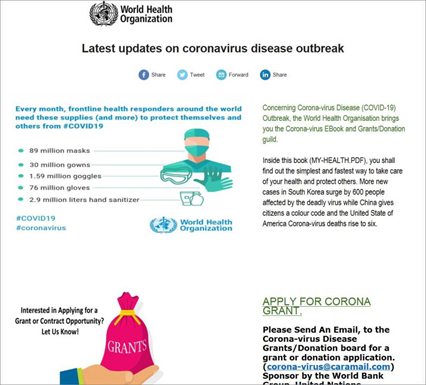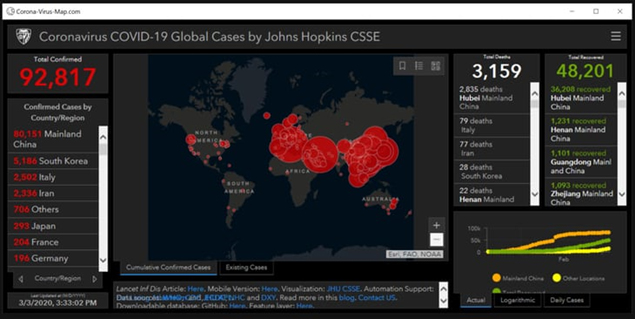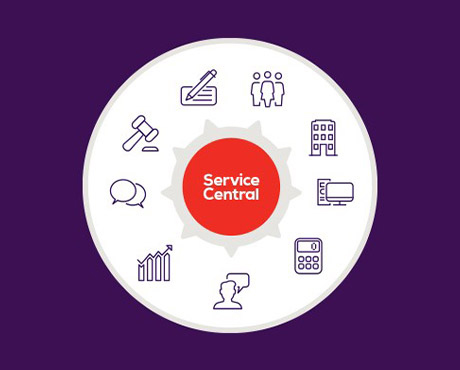
Include an additional SELT question
News 17 MayStaff can include an additional question in the Student Evaluation of Learning and Teaching (SELT) survey for units that are offered in Term 2 (Foundation Studies) (202334).
18 March 2020
Share
Cyber criminals are making the most of the COVID-19 pandemic by creating phishing schemes and fake websites that mimic legitimate sources of information about the virus. These malicious emails and websites can download malware (malicious software) to your computer, and trick you into revealing your personal details.
Here are two of the main schemes currently in operation, but there are many others and more are likely to arise as the situation continues.

World Health Organization phishing email
The World Health Organization (WHO) is a trusted source of information about the COVID-19 virus but cyber criminals have created a phishing email to steal user details and download malicious software. It is particularly difficult to identify as it utilises the real World Health Organization website to fool users into sharing their details.
Here’s how it works:
 This is just one example of a phishing email from a health organisation but there are many others.
This is just one example of a phishing email from a health organisation but there are many others.
What can you do?
To protect yourself against schemes like this:
John Hopkins University Mirror Website
The John Hopkins University Coronavirus map is a legitimate source of information on virus-spread throughout the world.
Cyber criminals are using information from this website to prompt users to download a piece of software to generate the map. As the map does not require any software to be downloaded, this is a prompt to download a piece of malware.
What can you do?
You can stay up-to-date on this and other Cyber Security news by joining the Cyber Security Workplace group and the Cyber Security SharePoint where our cyber-experts post frequently about industry news and advice.


Staff can include an additional question in the Student Evaluation of Learning and Teaching (SELT) survey for units that are offered in Term 2 (Foundation Studies) (202334).

Read a summary of the Academic Board meeting held on 12 April 2023.

The university takes academic misconduct very seriously. For a student, receiving an academic misconduct allegation letter can be highly stressful. Support is available.

Read the latest on the MFA for Students rollout.

If you are considering applying for promotion, come along to an upcoming information session – Understanding the New Academic Promotions Process.

ACU Co-Lab is proud to unveil its latest commercialisation program, Translate to Innovate Series, a specialised program targeting ACU’s research community.

A message from Executive Dean of Theology and Philosophy Professor Dermot Nestor: Purpose is what defines a Catholic university and galvanises the people who work within it.

See the TechOne P2P work instruction videos and modern slavery training modules which have been created to help grow your understanding of the subject matter, your responsibilities and the processes i...

A recording of last week’s Global Learning Showcase is now available to view if you were unable to attend. See what you may have missed.

Do you implement innovative strategies in your teaching that motivate and inspire students to learn? Receive recognition for your efforts by applying for an ACU Citation or VC Teaching Award.

Promotion recognises and rewards an academic’s achievements at their current level of appointment that warrant promotion to the next academic level. This year’s round marks a significant shift in the ...

A message from Executive Dean of Law and Business Professor Andrew O’Neil: I am committed to ACU’s continued success, with a contribution that places a premium on impact and growth.

Stay informed on recent changes to the Procurement Policy, approvals for purchases, how to raise mandatory purchase orders and related knowledge base articles.

As of Monday 8 May, Service Central phone support hours have changed to 9am–5pm AEST. Live chat remains available between 9am–5pm AEST.

You’re invited to attend local morning or afternoon tea events at the following local campuses hosted by the ACU ALLY Network, with the support of the Campus Deans and campus LGBTIQA+ Student Societie...

ACU’s business incubator, Co-Lab is delighted to announce details of its 2023 Circular Economy Incubator Series, designed for people and businesses with principles and practices of circular economics...

Do you have innovative ideas for program and curriculum development or initiatives to enhance student learning experiences that would benefit from funding? CEI has launched Teaching Development Grants...

Attend an online showcase to meet the Global Learning team, gain useful advice and find out how our various learning and engagement programs are developed and managed.

A message from Interim Provost Professor Meg Stuart: A unique new program for first year students is improving student retention at ACU.

Register for a webinar presented by the ACEN on the Graduate Outcomes Survey, focusing on a three-year evaluation of student participation in Work Integrated Learning.
Visit Service Central to access Corporate Services.